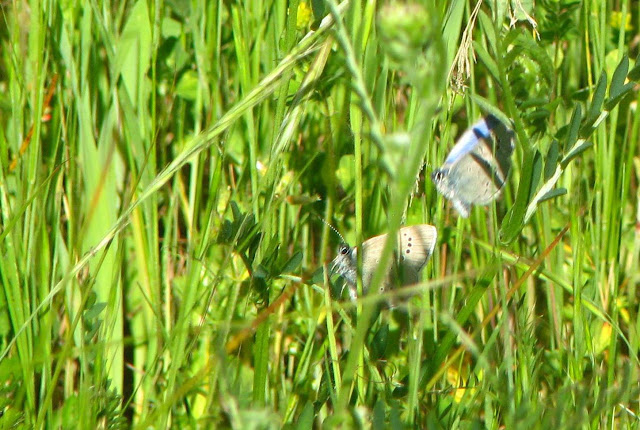
The pure sunshine weather streak has finally broken! Hopefully the 85 degree weather goes with it, and a little rain falls from all these clouds.
I haven't really talked about it yet so...
The duties of this job include:
Egg plot counts: exactly what it sounds like. Get down and count pinhead sized eggs, if they've hatched try to find the larvae.
You see some pretty neat insects this way too, since you're searching for such detail.
Here you can see two hatched eggs (they turn white and look like little beads) and a maybe 1mm larvae
They're a bit difficult to detect. For a while I had a 50% success rate (if each hatched egg = 1 larvae), but its dwindled substantially.Remember that picture where there were three eggs all stuck in together? Well here they are, all hatched out.
Cool finds while sampling
There are simply oodles of spiders. They aren't large, but these 'crab' spiders are perfectly deadly to the passing insect. This one is saying hello to you all.

There are these spiffy insects called snake flies. I guess giraffe-neck flies was too long

Behavior monitoring: Capture female Fenders, cool her down, mark her wing with a sharpy, cool her. Release her in the center of the plot and track her behavior for 15 minutes.
This is an unmarked female to the right.
Any time we re-encounter a marked butterfly, we make note. For science. The behaviors we note are sitting, basking (right), flying, chase (below), oviposit (laying eggs), and nectaring (2nd below).

She was really intent on this calochortus and let me get ridiculously close. The age classifications are Jailbait, Sorority Girl and Cougar. It took me a few tries to say anything about this without giggling. Red 3 is probably a Cougar.
Veg sampling measures the occurrence of nectar species (like lovely lupine and calochortus) in bloom in the plots and the height of the vegetation. The host lupine, and a common vetch that the Silvery blue will lay its eggs on.

This silvery is having a field day.
 The cucumber and calochortus again. Someday I'll stop posting pictures of calochortus, but its clearly not today...
The cucumber and calochortus again. Someday I'll stop posting pictures of calochortus, but its clearly not today...Other Flowers we see
 Surely that isn't some lovely poison oak blooming? It seems unfair that they have appealing flowers considering the meanness of their oil. A lone Pink of some kind.
Surely that isn't some lovely poison oak blooming? It seems unfair that they have appealing flowers considering the meanness of their oil. A lone Pink of some kind.Death camas and larkspur

One of those enormous bumble bees flopped around on this iris for a while. They're such unwieldy critters.


Columbine!!!Was exhilarated to find this little patch on the edge of the woods. I once had a goal to find wild columbine in the NW, it has been fulfilled multiple times but its still thrilling. Yes I find plants thrilling.
Distance sampling is something to do with the ratio of males to females, I have yet to conduct this task.
And of course data entry. Without discussion I found myself in charge of entering behavior data while the other tech enters all the vegetation data.
This is the watery part of the slough, great spot for migrating birds.
While gracefully stalking butterflies with my camera one afternoon (we weren't working) I heard the buzz of many bees. Too many for the poor flower cover. So I looked up. And what do you know, there's a wild nest formed in one of the oak burls.
Apparently the swarm showed up last summer and managed to survive, probably with a little help from the multiple meadow foam fields in the vicinity.
Some of the lupines are forming these weird mutant buds. My two guesses are either its a gall forming insect, or the flower is self-fertilizing to ensure some seeds. It appears pretty frequently throughout the population.

Thus far I have seen quail, pheasants, harriers, turkey vultures, orioles, goldfinches, jays... and heard cowbirds. Its a hopping place.
Made baklava. That's my culinary accomplishment for the week.
Have another calochortus photo, I insist! And have a delightful Wednesday!






















No comments:
Post a Comment
Note: Only a member of this blog may post a comment.